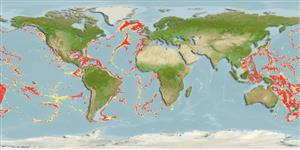>
Ophidiiformes (Cusk eels) >
Ophidiidae (Cusk-eels) > Neobythitinae
Etymology: Xyelacyba: Greek, xyele, -es = plane (tool) + Greek, kybeia, -ou = a fish (Ref. 45335).
Eponymy: Dr George Sprague Myers (1905–1985), an American ichthyologist, bio-geographer and herpetologist, was Professor Emeritus of Biological Sciences at Stanford, California. [...] (Ref. 128868), visit book page.
More on author: Cohen.
Environment: milieu / climate zone / intervalo de profundidade / distribution range
Ecologia
marinhas batidemersal; intervalo de profundidade 984 - 2500 m (Ref. 34024). Deep-water
Possibly worldwide in tropical and subtropical seas (but not yet caught in the eastern Pacific) (Ref. 34024). Eastern Atlantic: 2 specimens between 12°N and 9°25'N. Western Atlantic: Gulf of Mexico to off southern Brazil. Northwest Pacific: Ashizuri Cape, Japan.
Tamanho / Peso / Idade
Maturidade: Lm ? range ? - ? cm
Max length : 57.0 cm TL macho/indeterminado; (Ref. 3686)
Descrição breve
Chaves de identificação | Morfologia | Morfometria
Raios dorsais moles (total) : 89; Raios anais moles: 74. Body and tail strongly compressed, snout round and short, no spine on tip. Head and body uniformly whitish, margins of median fins light brown, jaws, pelvic fins, mouth and gill cavities deep brown. Peritoneum and stomach deep brown, intestine yellowish.
Body shape (shape guide): fusiform / normal.
A benthopelagic species at bathyal depth (Ref. 56809). Found on the continental slope (Ref. 75154). Rare species (Ref. 34024). Reproductive strategy possibly similar to other members of this family featuring oviparity, with oval pelagic eggs floating in a gelatinous mass (Ref. 205).
Life cycle and mating behavior
Maturidade | Reprodução | Desova | Ovos | Fecundidade | Larvas
Nielsen, J.G., D.M. Cohen, D.F. Markle and C.R. Robins, 1999. Ophidiiform fishes of the world (Order Ophidiiformes). An annotated and illustrated catalogue of pearlfishes, cusk-eels, brotulas and other ophidiiform fishes known to date. FAO Fish. Synop. 125(18):178p. Rome: FAO. (Ref. 34024)
Categoria na Lista Vermelha da IUCN (Ref. 130435: Version 2025-1)
Ameaça para o homem
Harmless
Utilização humana
Pescarias: sem interesse
Ferramentas
Relatórios especiais
Descarregue XML
Fontes da internet
Estimates based on models
Preferred temperature (Ref.
123201): 2.5 - 5.2, mean 3.5 °C (based on 1299 cells).
Phylogenetic diversity index (Ref.
82804): PD
50 = 1.0000 [Uniqueness, from 0.5 = low to 2.0 = high].
Bayesian length-weight: a=0.01122 (0.00514 - 0.02450), b=3.04 (2.87 - 3.21), in cm total length, based on all LWR estimates for this body shape (Ref.
93245).
Nível Trófico (Ref.
69278): 3.7 ±0.6 se; based on size and trophs of closest relatives
Resiliência (Ref.
120179): Médio, tempo mínimo de duplicação da população 1,4 - 4,4 anos (Preliminary K or Fecundity.).
Fishing Vulnerability (Ref.
59153): Moderate vulnerability (43 of 100).
🛈
